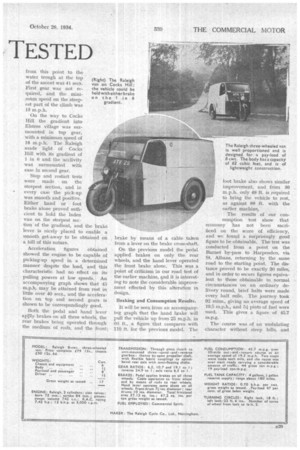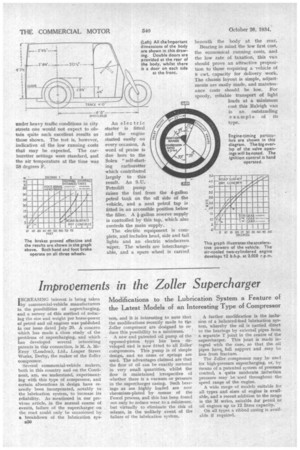THE NEW RALEIGH VAN TESTED
Page 42

Page 43

Page 44

If you've noticed an error in this article please click here to report it so we can fix it.
Good Performance and Economy of Operation are Features of this New Three-wheeled Van Built on Car Lines, in which a 742 c.c. V-twin Engine Supplies the Motive Power
THE success of the Raleigh three-wheeled van during the past few years has led to the introduction of a new model built on more generous lines, and with a greater carrying capacity than the previous machine. The new model, which has been designed for a payload of 8 cwt., was fully described in our issue dated July 6 last, and is now in full production.
Our first impression on taking over this van for the purpose of our road test was its handiness, and this impression was confirmed throughout the test in which we covered some 70 miles.
Car controls are used and the driver sits on the right-hand side of the e'ngine cowling, with central gear and brake levers, the accelerator, foot-brake and clutch being pedal operated as in usual car practice. This is a great improvement on the previous model where the driver sat astride the engine cowling, and the roominess and comfort of the driving compartment are excellent features of the new design.
No seat is provided on the near side of the vehicle, but a door is fitted to give access to the load. A further feature of interest to the driver is the provision of detachable side screens, which, when not in use, are stored on the inner sides of the body, being held in position by press buttons.
The body has a capacity of 62 cubic ft., and for the purpose of our test was loaded to.8 cwt., this weight including that of the observer. The. steering proved to be excellent, and the vehicle could be turned, without reversing, in a road of ordinary width. Corners could be taken fast with very little tendency towards rolling, and the springing was sufficiently hard to give a feeling of complete stability, without being at all harsh.
Ease of Control a Feature.
In every respect the machine handled well ; the controls are nicely placed, and it is extremely simple to drive. The gear change is easy and quick and the clutch light. The air
cooled engine is not unduly noisy and appears to revel in high speeds. Giving 12 b.h.p. at 3,000 r.p.m., a figure of 0.70 b.h.p. per cwt. gross
weight is obtained.
As the vehicle had covered only 170 miles when we took over we did not make any attempt to obtain a maximum speed figure ; we would, however, judge the maximum to be in the region of 55 m.p.h., and at a speed of 35 m.p.h. to 40 m.p.h. the engine was running easily and with plenty of power in hand.
That a sufficiency of power was available was amply demonstrated when climbing Brockley Hill, the speed at the foot of the 1 in 8f sec tion being 30 m.p.h. in top gear, despite the long rise from the foot of the hill. Second gear was engaged shortly after passing the old gradient sign marking the commencement of the steep section, and the time taken from this point to the water trough at the top of the ascent was 41 secs. First gear was not required, and the minimum speed on the steepest part of the climb was 15 m.p.h.
On the way to Cocks Hill the gradient into Elstree village was surmounted in top gear, with a minimum speed of 18 m.p.h. The Raleigh made light of Cocks Hill with its gradient of I in 6 and the acclivity was surmounted with ease in second gear.
Stop and restart tests were made on the steepest section, and in every case the pick-up was smooth and positive. Either hand or foot brake alone proved sufficient -to hold the laden van on the steepest section of the gradient, and the brake lever is nicely placed to enable a smooth get-away to be obtained on a hill of this nature.
Acceleration figures obtained showed the engine to be capable of picking-up speed in a determined manner despite the load, and this characteristic had no effect on its pulling powers at low speeds. An accompanying graph shows that 45 m.p.h. may be attained from rest in little over 40 secs., and the acceleration on top and second gears is shown to be correspondingly good.
Both the pedal and hand lever apply brakes on all three wheels, the rear brakes being operated through the medium of rods, and the front brake by means of a cable taken from a lever on the brake cross-shaft.
On the previous model the pedal applied brakes on only the rear wheels, and the hand lever operated the front brake alone. This was a point of criticism in our road test of the earlier machine, and it is interesting to note the considerable improvement effected by this alteration in design.
Braking and Consumption Results.
It will be seen from an accompanying graph that the hand hrake will pull the vehicle up from 25 m.p.h. in 60 ft., a figure that compares with 110 ft. for the previous model. The foot brake also shows similar improvement, and from 30 m.p.h. only 48 ft. is required to bring the vehicle to rest, as against 80 ft. with the earlier machine,
The results of our consumption test show that economy has not been sacrificed on the score of efficiency, and we found a surprisingly good figure to be obtainable. The test was conducted from a point on the Barnet by-pass to Harpenden, via St. Albans, returning by the same road to the starting point. The distance proved to be exactly 30 miles, and in order to secure figures equivalent to those obtainable in normal circumstances on an ordinary delivery round, brief halts were made every half mile. The journey took 92, mins., giving an average speed of 19.5 m.p.h., and 5i pints of fuel were used. This gives a figure of 45.7 m.p.g.
The course was of an undulating character without steep hills, and under heavy traffic conditions in city streets one would not expect to obtain quite such excellent results as those shown. The test is, however, indicative of the low running costs that may be expected. The carburetter settings were standard, and the air temperature at the time was 58 degrees F.
An electric starter is fitted and the engine started. easily on every occasion. A word of praise is due here to the Solex "self-start ing carburetter which contributed largely to this result. An S.U. Petrolift pump raises the fuel from the 4-gallon petrol tank on the off side of the vehicle, and a neat petrol tap is fitted in an accessible position below the filler. A fgallon reserve supply is controlled by this tap, which also controls the main supply.
The electric equipment is complete, and includes head, side and tail lights and an electric windscreen wiper. The wheels are interchangeable, and a spare wheel is carried beneath the body at the rear. Bearing in mind the low first cost, the economical running costs, and the low rate of taxation, this van should prove an attractive proposition to those requiring a vehicle of 8 cwt. capacity for delivery work. The chassis layout is simple, adjustments are easily made, and maintenance costs should be low. For speedy, reliable transport of light
loads at a minimum cost this Raleigh van is an outstanding example of its
type.




























































































